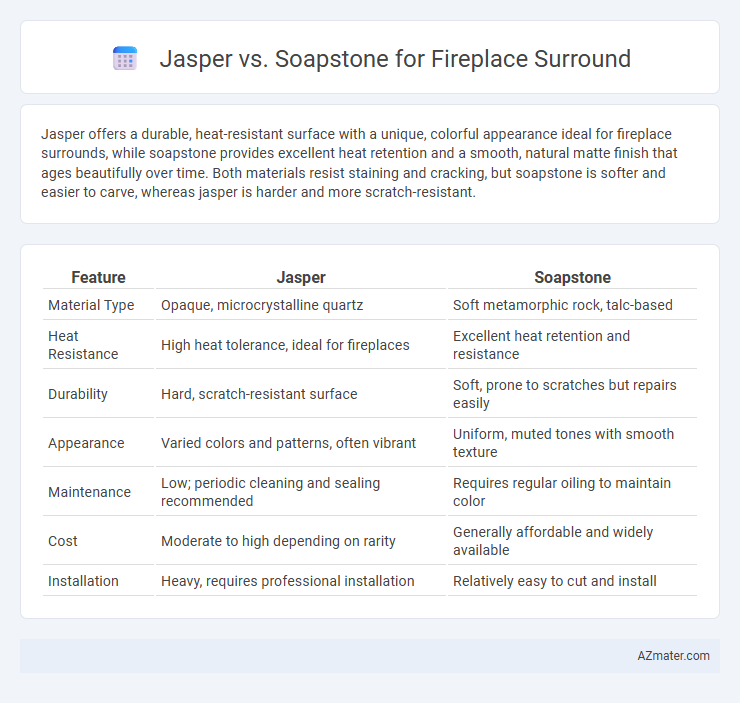Jasper offers a durable, heat-resistant surface with a unique, colorful appearance ideal for fireplace surrounds, while soapstone provides excellent heat retention and a smooth, natural matte finish that ages beautifully over time. Both materials resist staining and cracking, but soapstone is softer and easier to carve, whereas jasper is harder and more scratch-resistant.
Table of Comparison
| Feature | Jasper | Soapstone |
|---|---|---|
| Material Type | Opaque, microcrystalline quartz | Soft metamorphic rock, talc-based |
| Heat Resistance | High heat tolerance, ideal for fireplaces | Excellent heat retention and resistance |
| Durability | Hard, scratch-resistant surface | Soft, prone to scratches but repairs easily |
| Appearance | Varied colors and patterns, often vibrant | Uniform, muted tones with smooth texture |
| Maintenance | Low; periodic cleaning and sealing recommended | Requires regular oiling to maintain color |
| Cost | Moderate to high depending on rarity | Generally affordable and widely available |
| Installation | Heavy, requires professional installation | Relatively easy to cut and install |
Introduction: Choosing the Right Fireplace Surround
Jasper and soapstone are popular natural stone choices for fireplace surrounds, each offering distinct aesthetic and functional benefits. Jasper features vibrant patterns and excellent heat resistance, making it a stylish and durable option, while soapstone provides superior heat retention and a smooth, soothing texture with a classic, timeless appearance. Understanding the thermal properties, maintenance requirements, and visual appeal of Jasper and soapstone is essential for selecting the right fireplace surround that complements both design preferences and long-term performance.
Overview of Jasper and Soapstone
Jasper is a durable, dense stone known for its rich, earthy colors and unique patterns, making it a visually striking choice for fireplace surrounds. Soapstone is prized for its exceptional heat retention, smooth texture, and heat-resistant properties, providing both functionality and a soft, matte finish. Both materials offer longevity and aesthetic appeal but differ significantly in heat absorption and maintenance requirements.
Aesthetic Appeal: Visual Differences
Jasper fireplace surrounds showcase vibrant, multicolored patterns with rich reds, greens, and browns, creating a bold and dynamic visual statement. Soapstone offers a softer, matte finish with subtle veining in shades of gray, black, and green, lending a timeless, understated elegance to any fireplace design. The contrast between Jasper's dramatic, polished surface and Soapstone's smooth, natural texture allows for distinct aesthetic choices tailored to both traditional and contemporary interiors.
Heat Resistance and Thermal Performance
Jasper offers excellent heat resistance with a high melting point, making it durable for fireplace surrounds exposed to intense heat. Soapstone stands out for its superior thermal performance due to its ability to absorb, store, and evenly radiate heat over time, enhancing energy efficiency. Both materials resist cracking under temperature fluctuations, but soapstone's natural heat retention provides more consistent warmth after the fire has died down.
Durability and Longevity
Jasper is a dense, natural stone known for its exceptional durability and resistance to heat, making it ideal for fireplace surrounds subjected to high temperatures. Soapstone offers excellent heat retention and is highly resistant to thermal shock and wear, ensuring long-lasting performance in fireplace applications. Both materials provide longevity with low maintenance, but Jasper's hardness makes it more resistant to scratches, while Soapstone can develop a unique, patinated appearance over time.
Maintenance Requirements
Jasper fireplace surrounds require minimal maintenance, as their dense composition resists scratches and stains, needing only regular dusting and occasional cleaning with mild soap and water. Soapstone, while also durable and heat-resistant, demands periodic oiling to maintain its color and prevent surface drying or chalkiness. Both materials withstand high temperatures effectively, but jasper's lower porosity makes it less prone to moisture-related issues compared to soapstone.
Cost Comparison
Jasper typically costs between $50 and $100 per square foot, offering a mid-range option for fireplace surrounds with a balance of durability and aesthetic appeal. Soapstone ranges from $70 to $120 per square foot, often commanding a higher price due to its heat-resistant properties and unique veining. Homeowners should consider budget constraints alongside maintenance and longevity when comparing these materials for a fireplace surround.
Environmental Impact and Sustainability
Jasper, a natural stone, often involves extensive quarrying practices that may disrupt ecosystems and contribute to habitat loss, whereas soapstone extraction typically has a lower environmental footprint due to smaller-scale quarrying and higher yield per block. Soapstone is highly durable and heat-resistant, offering long-lasting use with minimal maintenance, which enhances its sustainability for fireplace surrounds. Both stones can be recycled or repurposed, but soapstone's resistance to wear and chemical inertness make it a more environmentally sustainable choice in the long term.
Design Versatility and Customization
Jasper offers extensive design versatility for fireplace surrounds with its wide range of natural colors and unique veining patterns, allowing for highly customizable aesthetics that complement various interior styles from rustic to modern. Soapstone provides excellent customization options due to its soft texture, enabling intricate carvings and smooth finishes, and its heat-retentive properties make it both functional and visually appealing. Both materials excel in durability, but Jasper's varied palette gives it an edge for personalized, bold design statements in fireplace surrounds.
Conclusion: Which Material Suits Your Needs?
Jasper offers exceptional durability and heat resistance, making it ideal for high-traffic fireplace surrounds that require long-lasting performance and minimal maintenance. Soapstone provides excellent heat retention and a smooth, natural appearance, which is perfect for those seeking a warm, rustic aesthetic along with the ability to radiate stored heat long after the fire has gone out. Choosing between Jasper and soapstone depends on whether your priority lies in rugged durability and low upkeep or superior heat storage and classic beauty.

Infographic: Jasper vs Soapstone for Fireplace Surround
 azmater.com
azmater.com